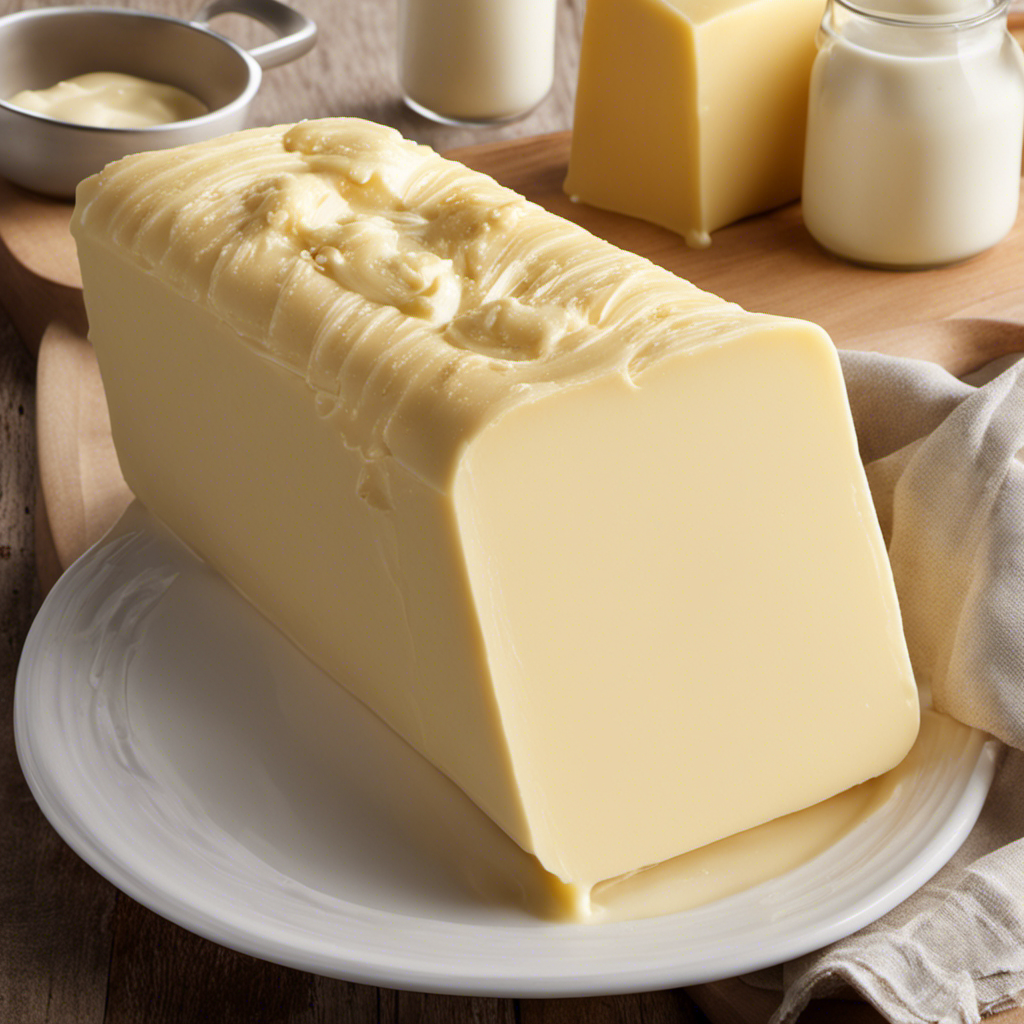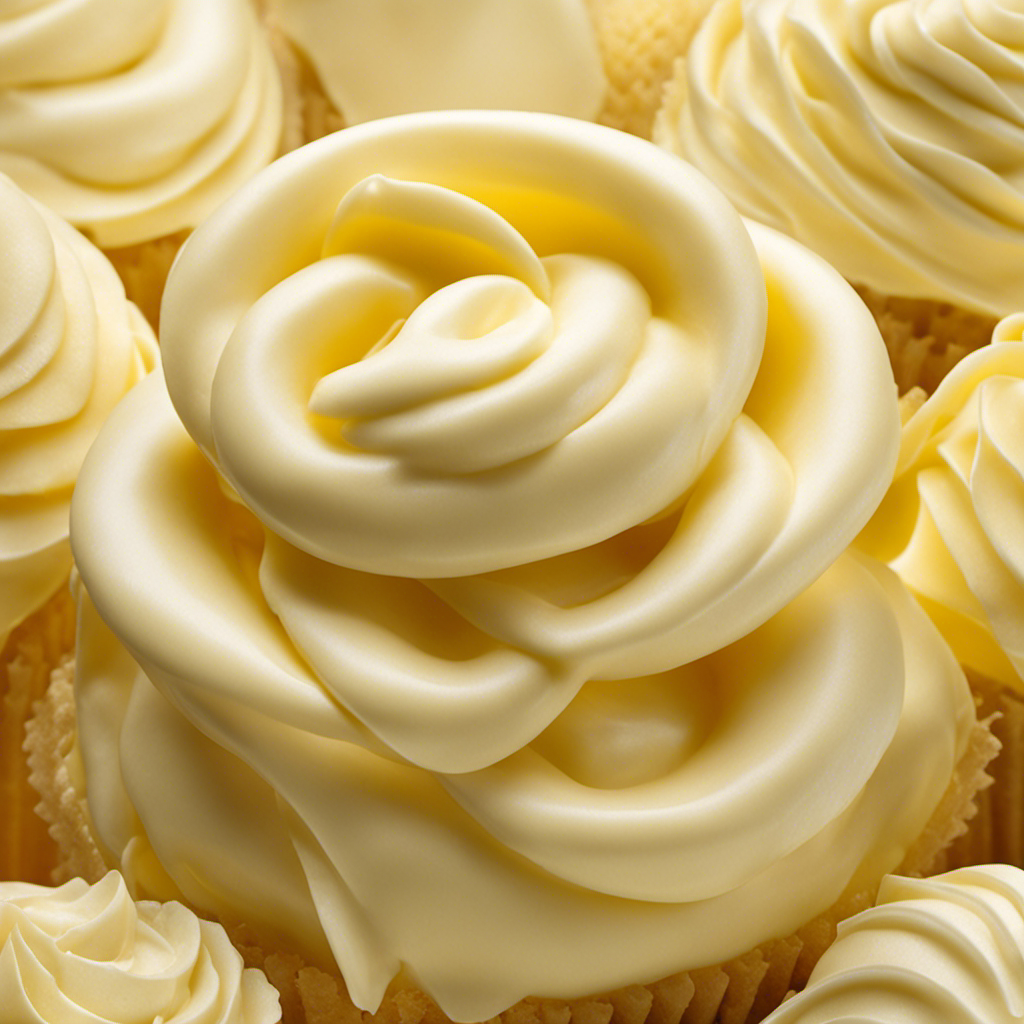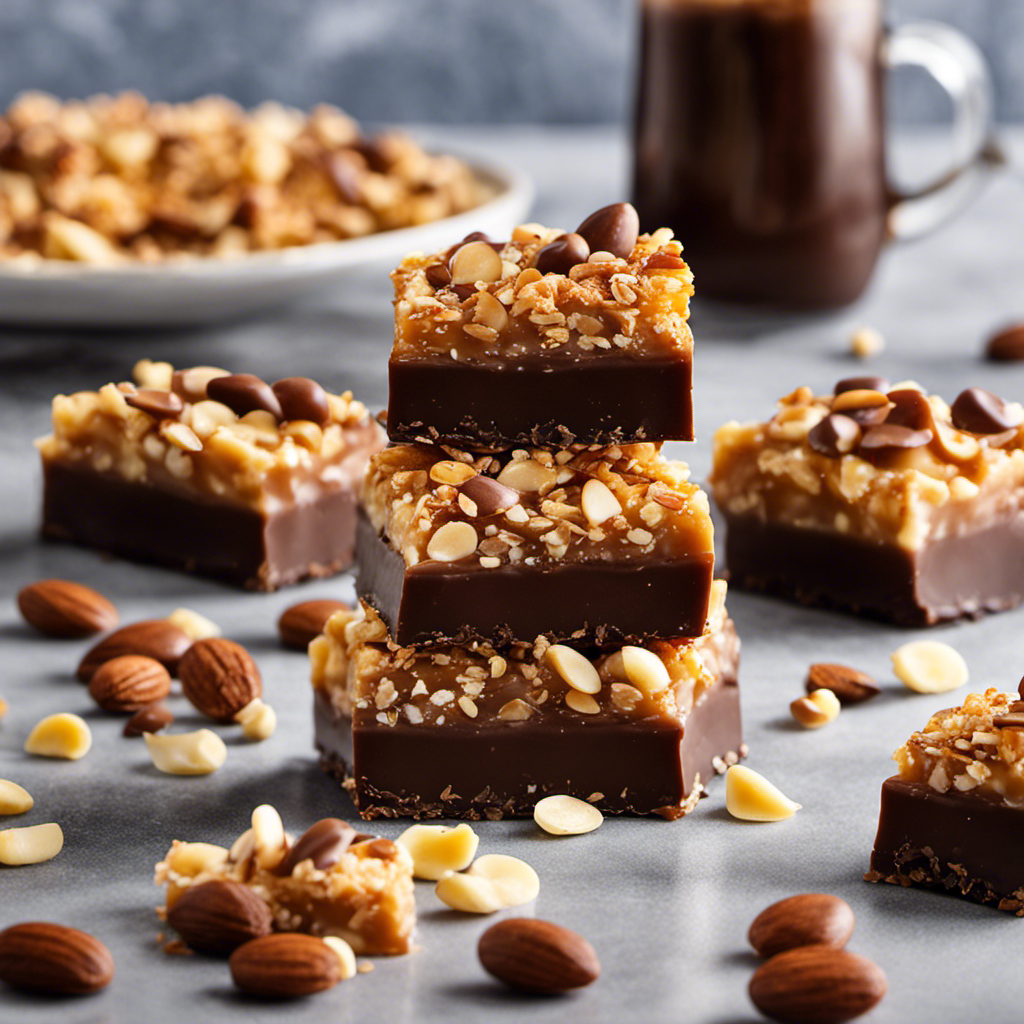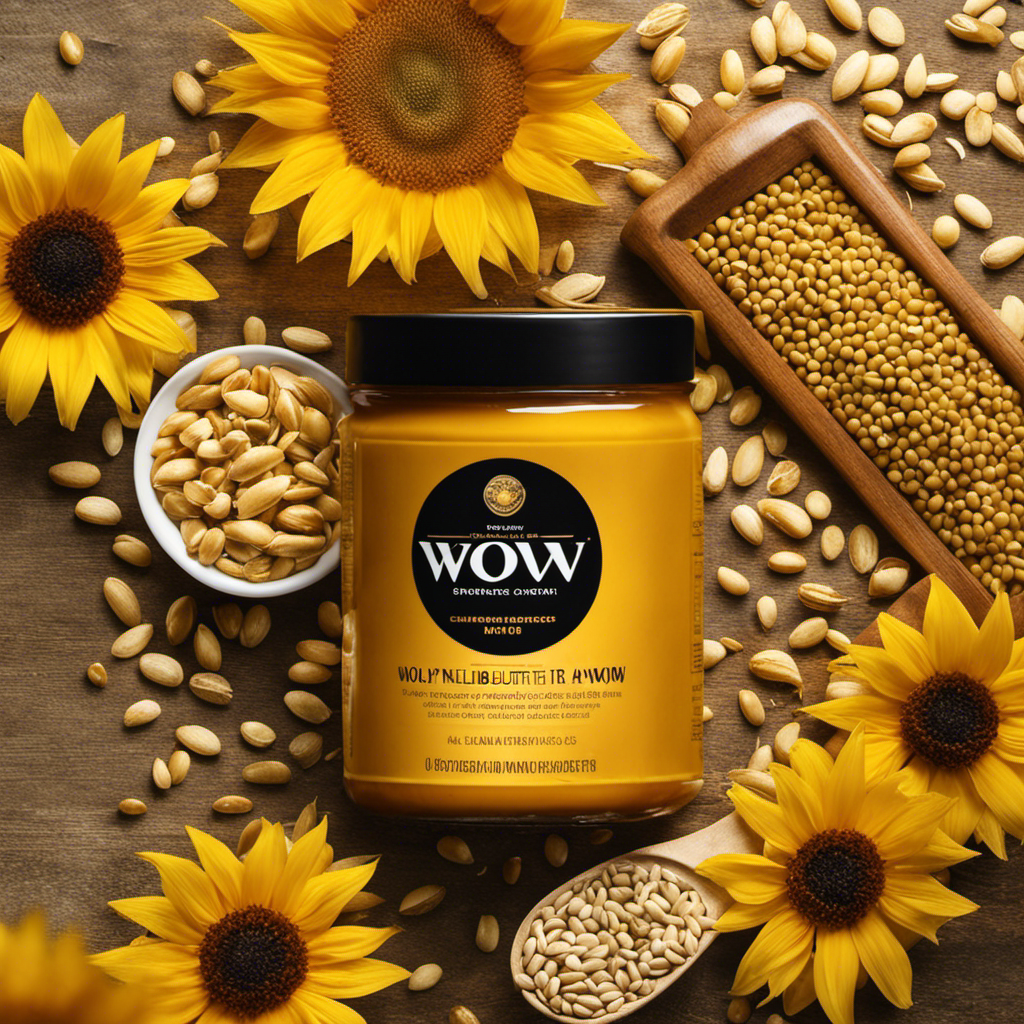I have frequently wondered, what exact color is butter? This question has left many people curious.
In this article, we will delve into the fascinating history of butter color, exploring the natural variations, cultural perceptions, and even the impact of diet on its hue.
We will also examine the different coloring agents used in butter production and how they affect its final color.
So, join me on this journey as we unravel the mystery behind the color of butter.
Key Takeaways
- Butter color is influenced by factors such as the cows’ diet, breed, processing methods, additives, and storage conditions.
- Cultural preferences play a significant role in determining the color of butter, with European cultures preferring golden butter and Asian and African cultures preferring pale butter.
- The color of butter holds symbolic meaning in many societies, with pale yellow symbolizing warmth and richness in Western cultures, and a lighter shade symbolizing purity and simplicity in East Asian cultures.
- Butter color does not necessarily indicate nutritional value, as it is primarily influenced by cows’ diet rather than its nutritional content.
History of Butter Color
The history of butter color is a fascinating topic to explore. Natural butter color has a long and interesting history.
In ancient times, butter was typically a pale yellow color, which was due to the diet of the cows and the natural pigments present in their food.
However, in the late 19th century, the industrialization of butter production led to the desire for a more consistent and vibrant color. This led to the introduction of artificial colorings, such as annatto and beta-carotene, to enhance the color of butter. These artificial colorings became widely used and are still commonly used today.
However, there has been a recent shift towards natural butter color, with consumers demanding more natural and organic products. This has led to the development of natural colorings derived from sources like marigold flowers and carrots, which provide a rich and appealing color to butter while maintaining its natural essence.
Natural Color Variations
Did you know that natural variations can affect the color of butter? Butter can range in color from pale yellow to deep yellow, and even white.
The color of butter is primarily influenced by the diet of the cows that produce the milk. Cows that graze on fresh grass tend to produce milk with a higher beta-carotene content, which gives the butter a rich, golden hue. On the other hand, cows that are fed a diet of hay or grains produce milk with less beta-carotene, resulting in a paler butter color.
Other factors, such as breed and season, can also contribute to natural color variations in butter. These natural color variations in butter reflect the diversity of diets and environments in which cows are raised.
Now, let’s explore the cultural perceptions of butter color.
Cultural Perceptions of Butter Color
When it comes to butter, cultural preferences play a significant role in determining the color of this dairy product. The symbolism of butter color varies across different cultures and can hold deep cultural meanings and associations.
Additionally, butter color variations can be influenced by factors such as the breed of cows, their diet, and the processing methods used.
Cultural Butter Preferences
Have you ever wondered why some cultures prefer their butter to be a rich golden hue, while others prefer it to be pale and almost white? The color of butter holds cultural symbolism and reflects regional variations in taste and preference. In some cultures, golden butter is associated with wealth, prosperity, and luxury, while in others, pale butter is seen as a sign of purity and simplicity. These cultural perceptions of butter color can be influenced by factors such as historical traditions, agricultural practices, and even climate. To illustrate this, let’s take a look at the following table:
| Culture | Butter Color |
|---|---|
| European | Golden |
| Asian | Pale |
| African | Pale |
In European culture, golden butter is often preferred due to its rich and creamy taste, while in Asian and African cultures, pale butter is favored for its milder flavor and versatility in cooking. These regional variations in butter preferences highlight the diverse ways in which different cultures perceive and value certain colors in their culinary traditions.
Symbolism of Butter Color
Imagine how fascinating it is to explore the symbolism behind the various hues of butter in different cultures.
The color of butter holds deep symbolic meaning in many societies, often reflecting cultural beliefs and values. For example, in Western cultures, the pale yellow color of butter is associated with warmth, comfort, and richness. It is often used to represent abundance and indulgence.
In contrast, cultures in East Asia prefer a lighter shade of butter, which symbolizes purity and simplicity. This difference in symbolism can be attributed to cultural differences and the psychological effects of color perception. Colors have the power to evoke emotions and influence our mood.
Understanding the symbolism behind butter color helps us appreciate the complexity of cultural beliefs and the impact colors can have on our perceptions.
Butter Color Variations
The various shades of butter hold different symbolic meanings in cultures around the world. When it comes to butter color, there is a distinction between natural and artificial colors.
Natural butter, made from cream, tends to have a pale yellow color due to the presence of carotenoids from the grass that cows eat. This color is often associated with freshness and naturalness.
On the other hand, artificial coloring agents can be used to enhance or alter the color of butter. These additives can create a vibrant yellow color, which is commonly associated with richness and indulgence.
The color of butter plays an important role in food presentation, as it can influence our perception of taste and quality. Now, let’s delve into the different butter coloring agents and their effects on the final product.
Butter Coloring Agents
You can easily find butter coloring agents in the baking aisle of most grocery stores. Butter color trends have evolved over the years, with consumers becoming more interested in vibrant and unique shades of butter.
Synthetic butter color additives are commonly used to achieve these desired colors. These additives are made from artificial dyes, such as Yellow 5 and Yellow 6, which are approved by the Food and Drug Administration (FDA) for use in food products. They are carefully formulated to provide consistent and reliable color results, allowing manufacturers to create butter in various shades, from pale yellow to deep golden.
Synthetic butter color additives are a popular choice among bakers and food manufacturers because they offer a convenient way to enhance the appearance of butter without altering its taste or texture.
Impact of Diet on Butter Color
When it comes to butter color and nutrition, there are a few important factors to consider.
The color of butter can vary depending on the diet of the cows and the amount of beta-carotene in their feed. Factors such as breed, season, and geographical location can also affect butter color.
Understanding the relationship between butter color and nutrition can provide valuable insights into the health benefits and potential risks associated with different butter varieties.
Butter Color and Nutrition
If you’re curious about the color of butter, it can vary depending on the diet of the cows it comes from. The color of butter ranges from a pale yellow to a deep golden hue. This variation in color is primarily due to the cows’ diet, which influences the levels of carotenoids present in their milk. Carotenoids are natural pigments found in plants, and they are responsible for the yellow and orange colors in butter. When cows graze on fresh grass, their butter tends to have a more vibrant yellow color due to the high carotenoid content in the grass. On the other hand, cows that consume a diet of hay or grains produce butter that is paler in color.
The table below illustrates the relationship between cow diet and butter color:
| Cow Diet | Butter Color |
|---|---|
| Fresh Grass | Vibrant Yellow |
| Hay | Pale Yellow |
| Grains | Light Cream |
Butter color trends have evolved over time, with consumers often associating a deeper yellow color with higher quality and richer flavor. This preference for a more vibrant hue has even led to the addition of food colorings to butter in some cases. Interestingly, the color of butter can also have psychological effects on consumers. Research suggests that individuals perceive butter with a deeper yellow color as being more flavorful and satisfying. This perception can influence their overall enjoyment of the food and may even affect their willingness to pay more for butter of a certain color.
Factors Affecting Butter Color
Now that we’ve discussed the relationship between butter color and nutrition, let’s delve into the factors that influence the appearance of butter.
In commercial butter production, there are several key factors that contribute to the color of the final product. These factors include:
-
Feed: The diet of the cows producing the milk can greatly impact the color of the butter. Cows that consume a diet high in beta-carotene, found in grass and hay, will produce milk that yields a vibrant yellow butter.
-
Breed: Different breeds of cows produce milk with varying levels of fat-soluble pigments, which can affect the color of the butter.
-
Processing: The method and duration of churning, as well as the temperature and pH during the process, can all influence the color of butter.
-
Additives: Some butter producers add natural or artificial colorings to enhance the appearance of the final product.
-
Storage: The storage conditions, such as exposure to light and temperature fluctuations, can also impact the color of butter over time.
Understanding these factors can help us appreciate the diverse range of butter colors available in the market.
Butter Color and Health
To maintain a healthy diet, you should consider the impact that butter color can have on your overall health.
The color of butter is often associated with its taste and quality. While many people prefer the traditional yellow color, it is important to note that the color of butter is primarily influenced by the diet of the cows that produce the milk.
However, it is also worth mentioning that the color of butter does not necessarily indicate its nutritional value.
If you are looking for natural butter color alternatives, there are a few options available. One alternative is to use grass-fed butter, which has a naturally rich yellow color due to the cows’ diet.
Another option is to add natural food coloring, such as turmeric or annatto, to achieve the desired color without compromising your health.
Butter Color in Culinary and Artistic Applications
Butter’s color is often used creatively in culinary and artistic applications. The warm and inviting hue of butter adds a touch of nostalgia and comfort to various aspects of our lives. Here are some ways in which butter color is utilized in fashion, interior design, and more:
-
Fashion: Butter-colored clothing and accessories evoke a sense of softness and elegance. It is a versatile color that can be incorporated into both casual and formal attire, bringing a sense of warmth and sophistication to any outfit.
-
Interior Design: Butter-colored walls, furniture, and decor create a cozy and inviting atmosphere in homes and commercial spaces. This color is often used in kitchens and dining areas to enhance the appetite and create a welcoming ambiance.
-
Art: Artists often use butter color in their paintings and drawings to convey a sense of warmth, comfort, and familiarity. It can be used to depict serene landscapes, still life compositions, or even portray emotions such as happiness and contentment.
-
Food Presentation: Butter is not only used for its taste but also for its rich yellow color. Chefs often incorporate butter in their culinary creations to add visual appeal and enhance the overall presentation of the dish.
-
Crafts and DIY Projects: Butter-colored materials such as fabrics, papers, and paints are widely used in various crafts and DIY projects. The soft and muted tone adds a touch of elegance and charm to handmade items.
Butter Color and Consumer Preferences
When it comes to your preferences, you may find yourself gravitating towards certain shades of yellow in culinary and artistic applications. Consumer preferences play a significant role in determining the color of butter. While the natural color of butter is pale yellow, some consumers prefer a deeper yellow hue, associating it with richness and quality. This preference for a specific shade of yellow can be seen in various industries, from food to art. Natural variations in butter color are influenced by factors such as the diet of the cows, which affects the levels of carotenoids in their milk. To give you a visual representation of the different shades of yellow in butter, here is a table:
| Shade of Yellow | Description |
|---|---|
| Pale Yellow | Light and subtle hue |
| Medium Yellow | Warm and inviting tone |
| Deep Yellow | Rich and vibrant color |
Understanding consumer preferences and the natural variations in butter color allows manufacturers and artists to cater to individual tastes and create products that truly resonate with their target audience.
Frequently Asked Questions
Is the Color of Butter the Same in All Countries?
In different countries, the perception of butter color can vary due to cultural differences. Additionally, some countries may use butter color as a marketing tool to attract consumers, adapting it to their preferences.
How Does the Color of Butter Affect Its Taste?
The color of butter can impact our perception of its taste due to color perception and cultural differences. It’s fascinating how our senses can be influenced by something as simple as color.
Can Butter Color Be Used as an Indicator of Its Quality or Freshness?
Butter color is not a reliable indicator of quality or freshness. It is mainly influenced by the cow’s diet. However, studies show that consumers may associate lighter-colored butter with higher nutritional value and freshness.
Are There Any Health Benefits or Risks Associated With Consuming Artificially Colored Butter?
There may be health risks associated with consuming artificially colored butter. Food coloring used in butter may contain additives that could have adverse effects on health. It’s important to be cautious when consuming artificially colored food products.
How Does the Color of Butter Affect Its Shelf Life or Stability?
The color of butter doesn’t directly affect its shelf life or stability. However, certain coloring agents used, both natural and artificial, may have different effects on the overall quality and preservation of butter over time.
Conclusion
In conclusion, the color of butter varies naturally and can be influenced by diet and coloring agents.
The history of butter color reveals cultural perceptions and culinary applications.
From pale yellow to deep golden, the shades of butter evoke a sense of warmth and richness.
As an artist might say, the color of butter is like a sun-kissed meadow, spreading its golden glow on our plates.
Understanding the nuances of butter color can enhance our culinary experiences and satisfy our consumer preferences.










